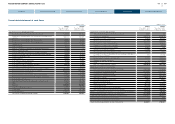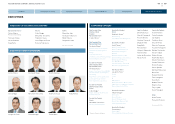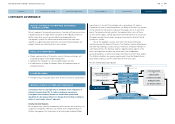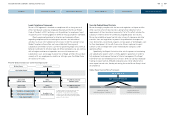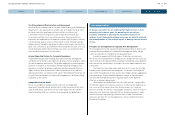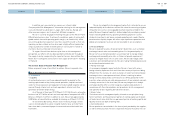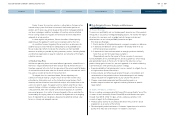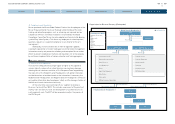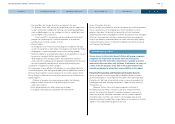Nissan 2013 Annual Report Download - page 40
Download and view the complete annual report
Please find page 40 of the 2013 Nissan annual report below. You can navigate through the pages in the report by either clicking on the pages listed below, or by using the keyword search tool below to find specific information within the annual report.
For example, the target for “product quality” is to attain the top level in
the Most Influential Indicators (MIIs) in each region. In order to achieve the
target, internal indicators for each model correlating with the MIIs have been
established. Progress of all quality improvement activities is monitored on an
ongoing basis with those internal indicators.
With respect to new model projects, in order to achieve quality targets,
milestone meetings are held for processes from design, production
preparation and production, at which key check points are confirmed, such as
achievement of quality targets, prevention of recurring problems, and adoption
of measures for potential risks related to new technology and mechanisms
and design changes. Commercial production can be started after confirmation
at the Start of Production (SOP) Judgment Meeting, which confirms all issues
are solved and quality targets can be achieved. The final decision that the
model can be sold is made at the Delivery Judgment Meeting after
confirmation of the quality of commercial production and preparedness for
service/maintenance.
As described above, Nissan is implementing thorough quality checks
before new model launches. Nissan is advancing quality improvement
activities after launch as well by constantly gathering quality information from
markets and promptly deploying countermeasures if problems arise. In case
safety or compliance issues do occur, necessary actions such as recalls are
implemented with close cooperation with the marketing side based on a
management decision reached by an independent process. Incidents are
thoroughly investigated and analyzed, and the lessons are applied to existing
or upcoming models to prevent a recurrence.
In addition to the above described activities, such as quality assurance
for new model projects and quality improvement activities on a daily basis, the
“Quality Risk Management” framework has been newly developed from fiscal
2009. While quality-related risks have hitherto been assessed and dealt with
for new models, the new framework represents a higher-level system to
ensure successful quality management for both on-going and future projects.
It involves an objective evaluation of whether risk exists and the level of such
risk for the Company and the assignment of responsible persons based on
the level for follow-up activities. These processes are implemented by the
Quality Risk Management Committee, chaired by an executive tasked with
heading this activity, twice a year.
3) Environment, Climate Change
The automotive industry is affected globally by various regulations related to
the environment and safety, such as exhaust emissions, CO2/fuel efficiency,
noise, chemical substances and recycling, and these regulations are getting
more stringent year by year. To comply with these regulations and to meet
society’s expectations, Nissan formulates an environmental strategy based on
materiality assessments of management risk factors, analyzing the Company’s
potential issues and opportunities and identifying issues that are crucial for
both Nissan and its stakeholders.
In this context, we believe that one effective solution from a long-term
perspective will be the widespread use of zero-emission vehicles. Nissan
started sales of Nissan LEAF, the world’s first affordable, mass-produced EV,
in 2010. The Renault-Nissan Alliance, moreover, has a goal of becoming a
leader in zero-emission vehicles and is considering partnering with national
and local governments to promote zero-emission mobility and to help build a
supporting infrastructure.
Additionally, Nissan will help to reduce CO2 emissions by continuously
developing technologies to improve fuel efficiency in internal combustion
engines and bringing them widely into the market. In particular, we will
promote highly fuel-efficient, low CO2 emitting vehicles named PURE DRIVE,
equipped with such technologies as our hybrid system, fuel efficient direct
injection engine and continuously variable transmission (CVT).
Stricter controls on the environmental impact of substances are being
implemented in countries around the world. In accordance with a globally
uniform policy on reducing the use of environment-impacting substances,
Nissan is strengthening the management of such substances, adhering to a
well-planned schedule for their reduction and advancing the use of alternative
substances. We voluntarily enforce stricter standards than those required by
the domestic laws of the countries where we operate in restricting the use of
substances scientifically recognized as being hazardous or carrying high
hazard risks, as well as those that advisory NGOs have pointed out as being
dangerous. Based on this policy, we have developed internal engineering
standards restricting the use of designated substances. The standards
identify the chemicals whose use is either prohibited or controlled, and they
are applied in selecting the materials, parts and articles for Nissan vehicles
from the stage of initial development.
39
CORPORATE GOVERNANCE
NISSAN MOTOR COMPANY ANNUAL REPORT 2013
CONTENTS
MANAGEMENT MESSAGES
CORPORATE FACE TIME
PERFORMANCE
NISSAN POWER 88


